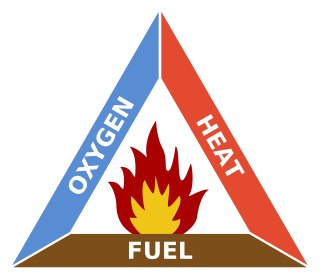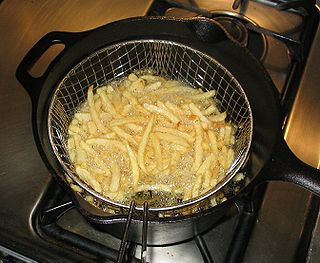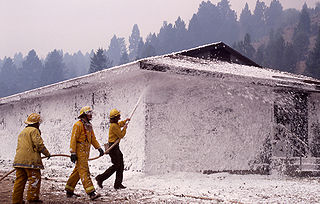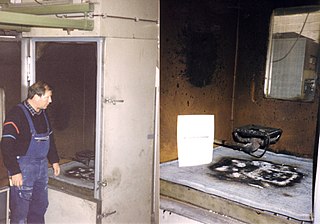
Fire is the rapid oxidation of a material in the exothermic chemical process of combustion, releasing heat, light, and various reaction products. At a certain point in the combustion reaction, called the ignition point, flames are produced. The flame is the visible portion of the fire. Flames consist primarily of carbon dioxide, water vapor, oxygen and nitrogen. If hot enough, the gases may become ionized to produce plasma. Depending on the substances alight, and any impurities outside, the color of the flame and the fire's intensity will be different.

Wool is the textile fibre obtained from sheep and other mammals, especially goats, rabbits, and camelids. The term may also refer to inorganic materials, such as mineral wool and glass wool, that have properties similar to animal wool.

Tinder is easily combustible material used to start a fire. Tinder is a finely divided, open material which will begin to glow under a shower of sparks. Air is gently wafted over the glowing tinder until it bursts into flame. The flaming tinder is used to ignite kindling, which in turn is used to ignite the bulk material, to produce a fire.
A modacrylic is a synthetic copolymer. Modacrylics are soft, strong, resilient and dimensionally stable. They can be easily dyed, show good press and shape retention, and are quick to dry. They have outstanding resistance to chemicals and solvents, are not attacked by moths or mildew, and are nonallergenic. Among their uses are in apparel linings, furlike outerwear, paint-roller covers, scatter rugs, carpets, and work clothing and as hair in wigs.

Firefighting is a profession aimed at controlling and extinguishing fire. A person who engages in firefighting is known as a firefighter or fireman. Firefighters typically undergo a high degree of technical training. This involves structural firefighting and wildland firefighting. Specialized training includes aircraft firefighting, shipboard firefighting, aerial firefighting, maritime firefighting, and proximity firefighting.

The fire triangle or combustion triangle is a simple model for understanding the necessary ingredients for most fires.

Fire control is the practice of reducing the heat output of a fire, reducing the area over which the fire exists, or suppressing or extinguishing the fire by depriving it of fuel, oxygen, or heat. Fire prevention and control is the prevention, detection, and extinguishment of fires, including such secondary activities as research into the causes of fire, education of the public about fire hazards, and the maintenance and improvement of fire-fighting equipment.

A fire retardant is a substance that is used to slow down or stop the spread of fire or reduce its intensity. This is commonly accomplished by chemical reactions that reduce the flammability of fuels or delay their combustion. Fire retardants may also cool the fuel through physical action or endothermic chemical reactions. Fire retardants are available as powder, to be mixed with water, as fire-fighting foams and fire-retardant gels. Fire retardants are also available as coatings or sprays to be applied to an object.

A chip pan is a deep-sided cooking pan used for deep-frying. Chip pans are named for their traditional use in frying chips.

Firefighting foam is a foam used for fire suppression. Its role is to cool the fire and to coat the fuel, preventing its contact with oxygen, thus achieving suppression of the combustion. Firefighting foam was invented by the Russian engineer and chemist Aleksandr Loran in 1902.
Active fire protection (AFP) is an integral part of fire protection. AFP is characterized by items and/or systems, which require a certain amount of motion and response in order to work, contrary to passive fire protection.
A fire class is a system of categorizing fire with regard to the type of material and fuel for combustion. Class letters are often assigned to the different types of fire, but these differ between territories; there are separate standards for the United States, Europe, and Australia. The fire class is used to determine the types of extinguishing agents that can be used for that category.

A flapper is a wildland firefighting tool that resembles a broom or a leaf rake with wide, overlapping metal bristles in the form of a hand fan. It is also called a swatter or a beater. It is designed for extinguishing minor fires in rural areas such as heaths. A flapper is built with a long handle and a series of lamellae which allows firefighters to stand well back from the fire. The lamellae are constructed in either rubber or steel, though practically any other fire-resistant material could be used.

Oil well fires are oil or gas wells that have caught on fire and burn. They can be the result of accidents, arson, or natural events, such as lightning. They can exist on a small scale, such as an oil field spill catching fire, or on a huge scale, as in geyser-like jets of flames from ignited high pressure wells. A frequent cause of a well fire is a high-pressure blowout during drilling operations.

Fire-retardant fabrics are textiles that are more resistant to fire than others through chemical treatment of flame-retardant or manufactured fireproof fibers.

Building insulation materials are the building materials that form the thermal envelope of a building or otherwise reduce heat transfer.

A combustible material is a material that can burn in air under certain conditions. A material is flammable if it ignites easily at ambient temperatures. In other words, a combustible material ignites with some effort and a flammable material catches fire immediately on exposure to flame.

A fire extinguisher is a handheld active fire protection device usually filled with a dry or wet chemical used to extinguish or control small fires, often in emergencies. It is not intended for use on an out-of-control fire, such as one which has reached the ceiling, endangers the user, or otherwise requires the equipment, personnel, resources or expertise of a fire brigade. Typically, a fire extinguisher consists of a hand-held cylindrical pressure vessel containing an agent that can be discharged to extinguish a fire. Fire extinguishers manufactured with non-cylindrical pressure vessels also exist but are less common.
Fire-safe polymers are polymers that are resistant to degradation at high temperatures. There is need for fire-resistant polymers in the construction of small, enclosed spaces such as skyscrapers, boats, and airplane cabins. In these tight spaces, ability to escape in the event of a fire is compromised, increasing fire risk. In fact, some studies report that about 20% of victims of airplane crashes are killed not by the crash itself but by ensuing fires. Fire-safe polymers also find application as adhesives in aerospace materials, insulation for electronics, and in military materials such as canvas tenting.

A thread is a long strand of material, often composed of several filaments or fibres, used for joining, creating or decorating textiles. In early humanity Egyptians were known for creating thread using plant fibers, wool and hair. Today, thread can also be made of many different materials including but not limited to cotton, wool, linen, nylon, silk, polyester etc. There are also metal threads, which can be made of fine wire.

















